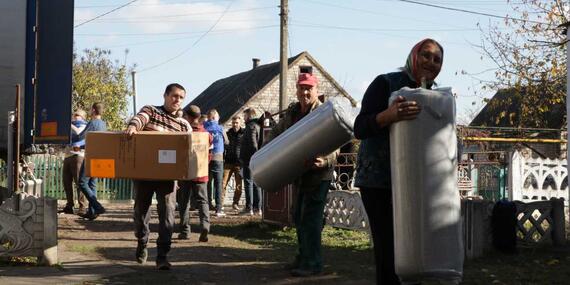Ukraine: UN relief chief warns of far-reaching impact of dam destruction

Under Secretary-General for Humanitarian Affairs and Emergency Relief Coordinator, Martin Griffiths’ remarks to the UN Security Council on Ukraine
Thank you so much Mr. President. Thank you for this chance to speak on this particularly tragic day.
We have all seen the terrifying pictures of the catastrophe unfolding in Kherson in Ukraine as we speak.
The destruction of the Kakhovka hydroelectric power plant dam is possibly the most significant incident of damage to civilian infrastructure since the start of the Russian invasion of Ukraine in February 2022.
The sheer magnitude of the catastrophe will only become fully realized in the coming days, but it is already clear that it will have grave and far-reaching consequences for thousands of people in southern Ukraine – on both sides of the front line – through the loss of homes, food, safe water and livelihoods.
Mr. President,
The Kakhovka Reservoir, which is formed by the Dam, is a lifeline in the region and a critical water source for millions of people, not only in Kherson but also Zaporizhzhia and Dnipro oblasts.
Ukrainian authorities report that at least 40 settlements are already flooded or partially flooded in Kherson oblast. This number is expected to rise in the coming days.
Severe impact is also expected in areas controlled by the Russian Federation where humanitarians, my colleagues, are still struggling to gain access.
Mr. President,
The UN and humanitarian organizations have already today stepped-up operations to try and address the impact of this event.
An emergency response is under way to provide urgent assistance to over 16,000 affected people. This support includes drinking water, cash assistance and psychosocial support.
These efforts are in addition to the Ukrainian Government’s response, which included sending additional equipment like power generators, mobile water filter equipment and transportation for water trucking, water being such a key issue due to this devastation.
Multidisciplinary mobile teams have also been deployed to train and bus stations across the oblast to support those seeking evacuations.
Cities in the west are preparing to receive those evacuees, these tragic families.
Mr. President
When I last briefed this Council on the situation in Ukraine just three weeks ago, I highlighted the civilian death and suffering being caused by the conflict on both sides of the front line. I mentioned then the loss of healthcare, water, electricity and heating for thousands of people. And the massive numbers of those forcibly displacement.
Today’s news means the plight of people in Ukraine is set to get even worse than the pictures that we saw then. Immediate humanitarian needs are expected to grow as floodwaters move over the coming days, and as assessments of the situation and the response continue.
The dam is a key source of agricultural irrigation in southern Kherson and the Crimean Peninsula. The sustained flooding displayed on our screens today will disrupt farming activities, damage livestock and fisheries, and bring widespread longer-term consequences. This is a massive blow to a food production sector which is already significantly damaged.
We are particularly concerned about the risks of mine and explosive ordnance contamination, as fast-moving water shifts projectiles to areas previously assessed as safe, thus putting people in further and unpredictable danger. At least 30 per cent of Ukraine’s territory is mine-contaminated, according to the Ukrainian authorities, with Khersonska oblast being the most affected.
The destruction of the dam may also negatively affect electricity generation. Additionally, any uncontrolled decrease in the water level of the Reservoir may negatively affect the safety of the Zaporizhzhia Nuclear Power Plant. Our colleagues at the IAEA are closely monitoring the situation. And as of this time no immediate threat has been reported.
The United Nations has no access to independent information on the circumstances that led to the destruction in the hydroelectric power plant dam. Yet, international humanitarian law is very clear: Installations containing dangerous forces, such as dams, must receive special protection precisely because their destruction can cause severe loss for the civilian population.
Constant care must be taken thus to spare civilians and civilian infrastructure throughout all types of military operations.
The damage caused by the dam’s destruction means that life will become intolerably harder for those already suffering from the conflict.
The consequences of not being able to deliver assistance to the millions of people affected by the flooding in these areas are potentially catastrophic.
We stand ready to do everything we can to ensure we reach all those who have been affected and need assistance.
But this won’t be easy, nor straightforward.
We are extremely concerned about people in affected areas that we are currently unable to reach, and we are operationally ready at any time to move with interagency convoys and aid personnel into Russian-controlled areas.
The people of Ukraine have shown incredible resilience. Our urgent humanitarian task is to continue to help them to survive and to be safe and then to get a future. We will do so to the best of our ability.
We stand ready to keep this Council abreast of any developments.
Thank you, Mr. President
